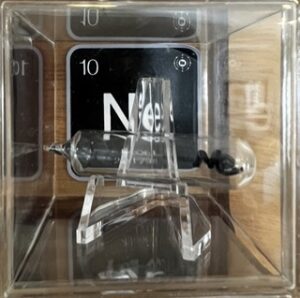Neon
Atomic Number: 10
Atomic Mass: 20.1797 u

In the late 19th century, the scientific world was brimming with excitement over the discovery of new elements, particularly those found in the atmosphere. One of the most notable of these discoveries was a noble gas that would go on to light up the night, revolutionize advertising, and find its place in modern technology.
A Glowing Discovery
In 1898, two British chemists, Sir William Ramsay and Morris Travers, made a groundbreaking discovery in their laboratory at University College London. While conducting experiments on liquefied air, they isolated a new gaseous element. When electricity was applied to the gas, it emitted a vibrant, reddish-orange glow. This striking display prompted them to name the element after the Greek word “neos,” meaning “new.”
This glowing gas was the second noble gas discovered by the duo. Ramsay and Travers were known for their work with atmospheric elements, having also isolated argon and krypton. Their discovery marked the birth of an element that would soon become synonymous with vibrant signage and futuristic aesthetics.
The Rise of a Symbol: Neon
Fast forward to 1910 in Paris, where French engineer and inventor Georges Claude found a way to harness this luminous gas for practical use. Claude developed the first commercially viable lighting tube, filling it with the new element and creating what is now recognized as the world’s first neon light. By bending glass tubes into various shapes and designs, he introduced an entirely new medium for advertising.
These brightly glowing signs soon became a cultural phenomenon, spreading rapidly across Europe and the United States. The bustling streets of cities like New York and Las Vegas became lit with colorful displays, making the technology a symbol of the vibrant urban lifestyle. Throughout the 20th century, these lights dominated the advertising world, capturing attention with their bold, mesmerizing glow.
Modern-Day Applications
While neon lights remain an iconic fixture in advertising, the uses of the gas have evolved significantly over time. Today, the gas plays a crucial role in many modern technologies, extending far beyond just illuminating the night.
One of the most critical uses in the 21st century is in the production of high-powered lasers, which are utilized in various fields including scientific research and medical procedures. Its stable properties make it ideal for applications requiring precision and durability.
In addition to lasers, this noble gas is also used in the production of high-resolution display screens, including those used in televisions, monitors, and smartphones. It helps provide the vibrant colors and clarity that modern consumers demand.
Another fascinating application is its role in cryogenics. Because it can maintain very low temperatures, this gas is often used in cryogenic refrigeration, particularly for cooling advanced scientific equipment such as MRI machines.
Moreover, the gas is an essential component in the manufacturing of semiconductor chips, which are foundational to modern computing and electronic devices. The technology sector, in particular, relies heavily on the unique properties of this element for the etching and production processes of these chips.
The Future of the Glow
Though its association with colorful signage remains strong, the gas continues to evolve and find new purposes in a technologically advanced world. Its applications in science, medicine, and industry ensure that this once “new” discovery will remain relevant for years to come.
From a laboratory in London to the streets of cities around the globe, this luminous element has proven itself to be far more than just a bright light. Its journey from discovery to modern-day applications serves as a reminder of the profound impact that scientific discoveries can have on our everyday lives, even those made over a century ago.
Though it may have started as just a curious glow in a chemist’s lab, this gas has illuminated the world in more ways than one.
 using WordPress and
using WordPress and
No responses yet